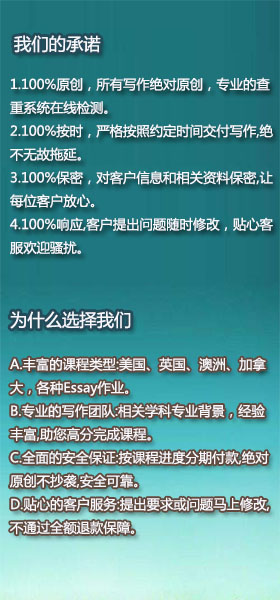铭信提供:北美心理学exam代考、论文代写、加拿大代考、加拿大网课代修、exam代考、、exam代考、北美代写、新加坡计算机代写、Java代写、IT代写、论文查重、mla格式代写、北美exam代考、论文代写、assignment代写、exam代考、apa格式代写、北美英语exam代考、论文代写、毕业exam代考、论文代写、Dissertation代写、Turnitin查重、代考、exam代考、paper代写、留学生online exam/quiz代考、网课代考、essay代写、assignment代写、exam代考、report代写、留学生exam代考、论文代写、留学生代考、留学申请文书代写...
2.a.v. Bargaining Power of Suppliers
The bargaining power of buyers and suppliers are two sides of the same coin. (Refer to course material - Topic 2 External Environment and Industry Evolution) The bargaining power of supplies directly influences the gain or loss of the buyers. In the specialty coffee cafe industry, the bargaining power of suppliers is cost and quality driven. For suppliers who are selling high-quality coffee beans, the bargaining power is relatively high as the specialty coffee cafe industry has to stick on using high-quality coffee beans if they would like to maintain the quality of their coffee. However, on the other hand, if the suppliers are selling low-quality coffee beans, it is totally the competition on the selling price. The lower the selling price of the coffee beans, the more buyers are willing to buy its beans. The bargaining power of suppliers who are selling low-quality coffee beans are low. Nevertheless, some leading cafes in the industry like Starbucks, they purchase a large amount of coffee beans from plenty of suppliers. The large supply and the diversification of supply chain make them having plenty of rooms to exercise coffee bean choices. Therefore, single suppliers do not have much impact on those leading cafes. Starbucks even purchases the entire yield to keep the cost and supply of Narino Supremo bean (one of the high-end coffee beans) stable. In the specialty coffee cafe industry, the bargaining power of suppliers is totally cost and quality driven. In this case, the bargaining power of suppliers is low.Starbucks's main suppliers are coffee bean suppliers and milk suppliers, and the quality of coffee beans is very important for Starbucks coffee. About 50% of the coffee beans come from Latin America, 35% from the Pacific Rim, and 15% from East Africa.Starbucks usually works directly with suppliers and provides training to them, so Starbucks and suppliersalways had a close relationship.Starbucks is an important customer for suppliers.40% of the Starbucks contract is about 3-5 years. Besides, Starbucks works directly with farmers and collaborators so that people living on the fringes of poverty receive income from coffee sales, this not only compensate for the cost of planting but also support their families.Under Starbucks' global sourcing strategy, Starbucks’ suppliers do not have strong bargaining power.
2.a.vi. Potential Rivals - Threat of New Entrants
In the Porter’s five force model, this force determines how easy the potential new players enter the industry. Threat of new entrants is high when the industry is profitable and few barriers to enter.
In the case of Starbucks, the threat of new entrants is moderate as there are numerous entry barriers in coffee chain industry. In the aspect of government control, there is no big barriers.New entrances can serve a coffee or cake pops easily because of the moderate costs of doing business and supply chain development. However, it is difficult for them to develop a strong band and compete against established bands like Starbucks unless they develop unique coffee or products, trends and new business attacking customers and grows exponentially like Starbucks do over 21,100 locations. Starbucks, on the other hand, have established a strong fashionable image and made their coffee as a part of customers’ routine, making it an unattractive market for new entrants. Moreover, economies of scales are barriers for new entrants. Newly entered coffee producers are seriously lacking in cost advantages.With more funding resources and bargaining power with suppliers, Starbucks can negotiate favorable interest rates and have higher profit margins from bringing the cost down compared with new players. Altogether, it is hard for new entrants to make an impact.
This analysis shows that by providing high-quality products and customer services, building brand loyalty and having economies of scales, Starbucks have a competitive advantage in the specialty coffee cafe industry. On the strength of five forces, Starbucks has acquired competencies and has been able to against competitive threats.
2.a.vii. Macro-Environmental Analysis (PESTLE Analysis)
Macro-environmental analysis addresses external factors, namely political, economic, social/cultural, technological, legal and environmental issues linked to the company.
For political factors, Starbucks have the needs of following laws and regulations in the countries. Any price regulations, political stability, tax policy, employment law, environmental regulation, trade restriction and property protection acts have their impacts on Starbucks’s business. For those countries improving infrastructure and promoting regional integration, opportunity is provided for Starbucks to access more markets and suppliers and expand globally. However, for those developing countries persisting bureaucratic, it is difficult for Starbucks to expand its business.
For economic factors, type of economic system, regional economic growth rate, interest rates, discretionary income, local currency exchange rates, taxation level and the inflation rate have major impacts on Starbucks’s profitability, operation and decision making process. Starbucks gain revenues in those developing counties which have high economic growth with low unemployment rate. At the same time, the expense is also increase as another threat due to coffee bean farms’ labour cost increment in the developing countries.
Apart from economic factors, socio-cultural factors play an important role when Starbucks launches a product in global market. Some factors may affect customers need and market size, namely age, population, education, class structure, family pattern, health consciousness, working environment, lifestyle and local culture. For example, Starbucks invests in Italian-style beverage and provides a seductive atmosphere, biscotti on the counter and soft jazz or opera in order to comfort Italian counterparts.
For technological factors, factors like research and development, system automation, technology incentives may influence a business and its products. For Starbucks, it uses new technology and equipment among countries and increases the productivity. Take Innovative technology and Biotechnological developments as examples. Innovation technology allow Starbucks’s customers enjoying the free Wi-Fi at store, apps based discount coupons and mobile payments. Meanwhile, biotechnological developments allow Starbucks diversifying its drink menu by selection of coffee bean combination and flavored coffee.
For legal factors, laws and regulations in markets and origin of raw material affect food and beverage industry. Starbucks should stay alert about health related policies, especially for those caffeine products, and ensure that it does not violate any law and regulation. Apart from health related policies, an introduction of new employment regulation, trade regulation, customs requirement or licensing regulation among counties may also have impact on Starbucks’s business. These external factors give Starbucks opportunities to improve its performance or threaten to enter into local markets respectively.
Lastly, for environmental factors, it identifies the effects of environmental conditions and changes on business. Such trends of business sustainability, environmentally friendly and responsible sourcing emphasizes corporate social responsibility in the supply chain. Yet, Starbucks has enhanced its performance and created responsible sourcing policies like recyclable packaging.
To sum up, this analysis shows the external factors in Starbucks’s macro-environment. Overall, it proves that Starbucks has a quite stable external environment. The analysis indicates that it has plenty of room for further global growth as it presents the opportunities and works to address the identified threats.
2b. KEY SUCCESS FACTORS IN THE SPECIALTY COFFEE CAFE INDUSTRY
To be success in an industry, a company should have its own strategy which can produce competitive advantages and make itself irreplaceable in the industry. Running a business in the specialty coffee cafe industry is just the same, here are some key success factors in the specialty coffee cafe industry:
First of all, to be success in the specialty coffee cafe industry, a cafe should offer high-quality coffee. Coffee is the main product offers in the specialty coffee cafe. In order to win the customers’ hearts and hold a leading position in the specialty coffee cafe industry, a cafe must offers high-quality coffee. Starbucks did a great job on winning customers’ hearts in the specialty coffee cafe industry by offering a cup of high-quality coffee. Coffee beans are the base and the “soul” of a cup of coffee. Starbucks breaks the traditional that only Japanese and Europeans will buy high-quality coffee beans but also American does. Starbucks even roast the coffee beans itself to keep the quality. As mentioned in the Starbucks case, “roasting is close to an art form at Starbucks.” It shows how serious Starbucks is on producing a cup of coffee and it takes Starbucks to the leading position in the specialty coffee cafe industry. A cup of high-quality coffee with irreplaceable taste is obviously a key success factor in the specialty coffee cafe industry.
Secondly, building long-term relationship with customers is also one of the key factors to success in specialty coffee cafe industry. Develop and maintain good relationship with customers is increasing the brand loyalty of the customers. Not only the coffee should hit the taste of the customers, but also let the customers to enjoy the cup of coffee. As a leading specialty coffee cafe in the industry, Starbucks’s objective is to create long-term relationship with customers. Starbucks builds good relationship with customers through its employees. Starbucks’s employees are well-trained to help customer on trailer made their own “coffee experience”. Building long-term relationship with customers helps to get higher brand loyalty from customers and to lead a cafe to the road of success in the industry.





